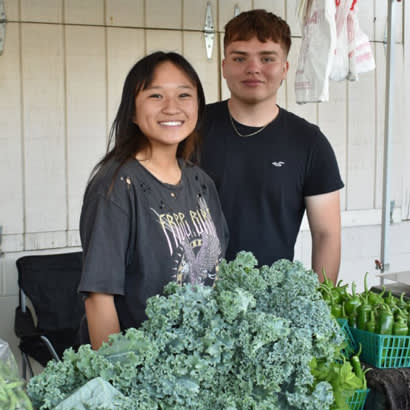
Pictured: A farmers market provides fresh produce at the Kerman Wellness Hub. Photo courtesy of Kerman Parks, Recreation, and Community Services.
NRPA has developed a new resource, Community at the Table: Creating Culturally Responsive Nutrition Education. This guide offers five practices to support park and recreation professionals with centering community and culture that can be applied to any park and recreation program. We recommend following them in order:
1. Ask community members what they want in your park and recreation program
2. Center and elevate community voices throughout the program
3. Acknowledge systemic barriers
4. Evaluate improved cultural well-being
5. Continually offer training and resources in cultural humility
How is your agency embodying the five practices described below?
1. Ask community members what they want in your park and recreation program
Step one is to learn from community members what they want and need from a park and recreation program. Engage community members with questions to inform the content, structure, outcomes and purpose of your program. Invest time and attention toward engaging historically and currently underrepresented community members. If your nutrition program lacks participation from a demographic in your community, critically consider how your agency conducts community engagement and work with trusted community groups to identify more effective methods for engaging and welcoming underrepresented community members.
Whoever your audience is, be sure to employ a variety of outreach methods to best inform a program that your primary audience will have the capacity, availability, interest and excitement to attend. Visit this section of the Community at the Table resource for sample questions that can tailored to your park and recreation program.
2. Center and elevate community voices throughout the program
Once you’ve gathered community input, it is essential that you apply it in a timely manner. Valuing community voice requires agencies to demonstrate community prioritization through swift action on community needs and continuous inquiry for program guidance. Identify ways for community voices to continually guide your program through leadership roles, peer-to-peer learning and significant opportunities for participants to share their knowledge and experiences. Visit this section of the Community at the Table resource for recommendations to center community experience in P&R nutrition programs.
3. Acknowledge systemic barriers
In programs focused on health topics, park and recreation leaders can expand the discussion from individual behavior strategies, to addressing community-wide challenges that contribute to chronic disease and health disparities. It is important to acknowledge the environmental settings, policies and systems that can contribute to poor health outcomes. These barriers could include insufficient access to transportation, quality housing, nutritious foods, healthcare, secure employment, safe and affordable places to recreate, education and more. These conversations require a trusting space for participants to openly discuss individual and community-level barriers. Visit this section of the Community at the Table resource for sample activities to open discussion on community-level barriers.
4. Evaluate improved cultural well-being among other outcomes
We encourage park and recreation agencies to brainstorm with community members how they want to define and measure improved well-being in their community. When involving community members in the development of your program in Step 1 of this guide, ask how they want to improve their health and well-being to develop holistic, community-informed outcomes based on their responses. This information can form the core of what you aim to evaluate. In addition to community-informed outcomes, park and recreation agencies are encouraged to evaluate program impact on cultural well-being and additional interconnected dimensions of well-being. Visit this section of the Community at the Table resource for sample questions that can be used to evaluate improved cultural well-being.
5. Continually offer training and resources for staff, volunteers and community members in cultural competency and cultural humility
Cultural humility is a lifelong process of learning about other cultures, reflecting on your own relationship to culture, and being open and responsive to elements of cultural identity that are most important to another person. Seek trainings and resources for staff and volunteers to embrace cultural humility and support programming that is culturally sustaining. Find ways to honor community and culture in all aspects of your department’s facilities, programs and services. Host events, community talks and workshops on cultural humility for community members to benefit and learn ways to engage with the cultures of their neighbors. Local community-based organizations, universities, hospitals and health departments are great partners to bring additional learning opportunities and resources on cultural humility and competency to your park and recreation center.
For additional resources, questions or requests, email NRPA at DEI_Education@nrpa.org.
Liliana Ruiz Fischer, MPH (she/her/ella) is a health program manager at NRPA.

